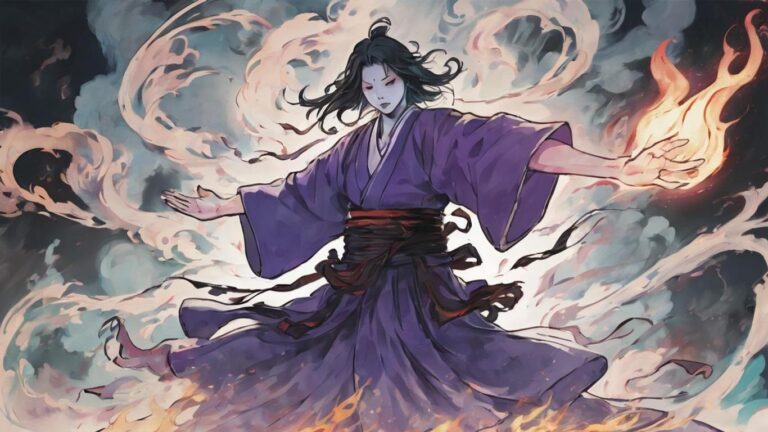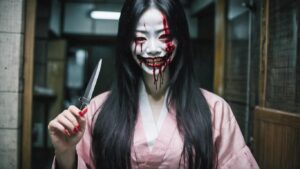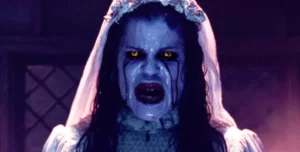Table of Contents
“Yūrei” is a term in Japanese folklore that refers to a type of ghost or spirit. These spirits are typically believed to be the souls of the deceased, especially those who died in a violent or unjust manner. Yūrei are often depicted as pale, with long, disheveled hair, and they may be dressed in burial kimono or burial shrouds.
Commonly associated with traditional Japanese beliefs and cultural practices, yūrei are thought to be bound to the world of the living due to unfinished business, strong emotions, or a lack of proper funeral rites. They may seek vengeance, resolution, or simply be lost and unable to move on to the afterlife.
Yūrei have been a prominent theme in Japanese literature, art, and entertainment, including kabuki plays, ukiyo-e woodblock prints, and contemporary horror films. They are distinct from the Western concept of ghosts in terms of appearance, behavior, and cultural context.
Origin
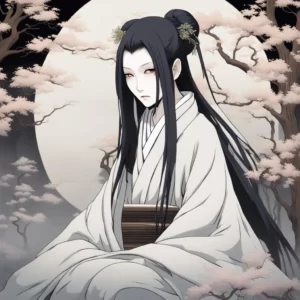
The concept of yūrei has deep roots in Japanese folklore and cultural beliefs. The origins of yūrei can be traced back to traditional Japanese religious and spiritual practices. Shintoism and Buddhism, the two major religions in Japan, have played significant roles in shaping the beliefs about the afterlife and spirits.
In Shintoism, the indigenous religion of Japan, there is a belief in kami, which are spirits or deities associated with natural elements, objects, and ancestors. Ancestral spirits, known as “mitama,” are thought to linger and may be venerated or appeased through rituals.
Buddhism, which was introduced to Japan from China and Korea, brought with it concepts of karma, reincarnation, and the cycle of death and rebirth. The idea that the deceased could be bound to the world of the living due to unresolved issues or attachments became integrated with existing Japanese beliefs.
Over centuries, a rich tapestry of folklore, ghost stories, and cultural practices developed around the idea of spirits that had not moved on to the afterlife. This folklore includes tales of tragic deaths, unfulfilled desires, and the supernatural. The visual depiction of yūrei, with their distinctive appearance and attire, has been shaped by artistic representations in various forms, such as ukiyo-e prints and kabuki theater.
Yūrei continue to be a fascinating and enduring element of Japanese culture, influencing literature, art, and popular media, including horror films and manga. Their origin is deeply intertwined with the spiritual and cultural history of Japan.
Physical Description
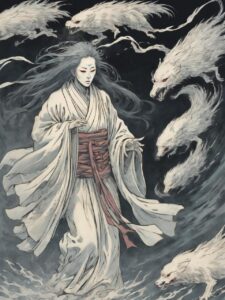
Yūrei are typically depicted with distinct physical characteristics in Japanese folklore, art, and popular culture.
Pale Appearance: Yūrei are often described as having a pale or white complexion. This is a symbolic representation of their connection to death and the afterlife.
Long, Disheveled Hair: Female yūrei, in particular, are often portrayed with long, unkempt black hair that partially or completely covers their faces. This hair is sometimes associated with mourning or is thought to add to their eerie and otherworldly appearance.
White Burial Kimono or Shroud: Yūrei are often depicted wearing traditional burial attire, such as a white kimono or burial shroud. This reflects their connection to death and the rituals surrounding it.
Lack of Feet: In some depictions, yūrei are shown as floating or hovering above the ground, with no visible feet. This is a supernatural element that adds to their eerie and ghostly nature.
Emaciated or Decomposed Features: Some yūrei are portrayed with emaciated or decomposed features, emphasizing their connection to death and the spirit world.
No Legs: In certain stories, yūrei are described as having no legs, and they may float or glide instead of walking. This further emphasizes their ethereal and ghostly nature.
White Funeral Obi (Sash): In the case of female yūrei, they may be depicted wearing a white funeral obi, a sash traditionally worn with a kimono during mourning.
The visual representation of yūrei has evolved over time and can vary based on cultural and artistic interpretations. While these characteristics are common, they are not universal, and different stories and artworks may present variations on the theme of yūrei.
Personality
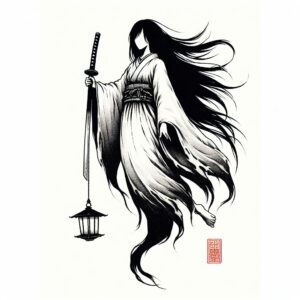
The personality of yūrei, as portrayed in Japanese folklore, literature, and popular culture, is often shaped by the circumstances of their death and the emotions they experienced during their lives. Common themes associated with the personality of yūrei:
Vengeful Spirits: Many yūrei are depicted as harboring strong feelings of anger, resentment, or a desire for revenge. This vengefulness is often linked to the circumstances of their untimely or unjust deaths, such as murder or betrayal.
Unfulfilled Desires: Yūrei may be portrayed as lingering in the physical world due to unfulfilled desires or unresolved issues from their past lives. These desires could range from love and attachment to a particular place or person.
Sorrow and Regret: Some yūrei are characterized by deep sorrow and regret. They may be unable to find peace due to the emotional burdens they carry, such as regret over actions taken in life or the pain of separation from loved ones.
Lost and Confused: In certain stories, yūrei are depicted as lost or confused spirits, unable to find their way to the afterlife. This portrayal emphasizes their tragic and pitiable nature.
Yearning for Connection: Yūrei might seek connection with the living, especially with family members or loved ones left behind. This yearning for connection can drive their interactions with the living and be a central theme in ghost stories.
Malevolent Intentions: While some yūrei may be depicted as relatively benign or sorrowful, others are portrayed as having malevolent intentions. They may seek to harm the living or cause disturbances as a form of revenge or expression of their anguish.
Atonement: In some stories, yūrei may strive for atonement or seek a resolution to their lingering issues, leading to a more positive resolution for both the spirit and those affected by its presence.
Explanation of the Myth
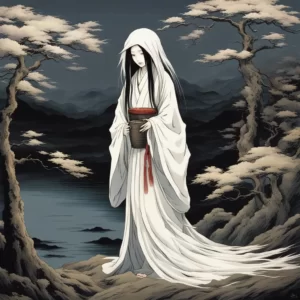
The myth of yūrei is deeply rooted in Japanese folklore, and it reflects cultural beliefs about death, the afterlife, and the spiritual realm. The concept of yūrei is influenced by a combination of Shinto and Buddhist traditions, as well as historical and societal factors. Here’s an explanation of the myth:
Spiritual Beliefs:
Shinto Influence: Shintoism, the indigenous religion of Japan, contributes to the belief in spirits, including ancestral spirits or kami. The idea that spirits can linger in the human realm aligns with the concept of yūrei.
Buddhist Influence: Buddhism, introduced to Japan from China and Korea, brought concepts such as karma, reincarnation, and the cycle of life and death. The belief in an afterlife and the potential for spirits to be trapped in the human realm due to unresolved issues also influenced the development of yūrei mythology.
Unresolved Emotions and Tragic Deaths:
Yūrei are often associated with individuals who experienced particularly tragic or unjust deaths. This could include death by murder, suicide, or accidents. The belief is that such individuals may be unable to move on to the afterlife due to lingering emotions, unfinished business, or a lack of proper funeral rites.
Cultural Practices:
Traditional Japanese funeral and mourning practices, including the use of white burial attire, play a role in the visual representation of yūrei. The ghostly appearance, with long disheveled hair and white clothing, reflects the cultural understanding of death and the supernatural.
Vengeance and Retribution:
Many yūrei myths involve themes of vengeance and retribution. The spirits may seek revenge against those who wronged them or may try to fulfill some unresolved goal. This adds a dramatic and often frightening element to the stories.
Folktales and Ghost Stories:
Yūrei myths have been perpetuated through generations in the form of folktales, ghost stories, and theatrical performances. These stories serve both as cautionary tales and as a way to explore themes of morality, justice, and the consequences of one’s actions.
Cultural Evolution:
Over time, the yūrei myth has evolved and adapted to changes in Japanese society. Depictions of yūrei can be found in traditional art, literature, and contemporary media, including horror films and manga. The myth continues to be a dynamic part of Japanese cultural expression.
Ralated and similar creatures
Various cultures around the world have their own myths and folklore surrounding spirits, ghosts, and supernatural entities. While the specifics differ, there are similar themes and creatures found in different cultures.
White Lady (Europe): Similar to the yūrei, the White Lady is a common figure in European folklore. She is often associated with tragic tales, such as lost love or betrayal, and is said to haunt specific locations.
La Llorona (Latin America): Translating to “The Weeping Woman,” La Llorona is a figure found in Mexican, Central American, and South American folklore. She is a ghostly woman often seen near bodies of water, mourning the loss of her children.
Banshee (Irish Mythology): In Irish folklore, the banshee is a female spirit associated with death. She is said to wail or keen to foretell the death of a family member.
Krasue (Southeast Asia): Found in Thai, Cambodian, and other Southeast Asian folklore, the Krasue is a nocturnal female spirit. It is often depicted as a floating head with trailing organs and is associated with horror and malevolence.
Churel (South Asia): In South Asian folklore, particularly in India and Pakistan, the Churel is a female ghost believed to be a woman who died during childbirth or under other tragic circumstances. She is often depicted as a vengeful spirit.
Goryō (Japan): Similar to the yūrei, the goryō is a vengeful spirit in Japanese folklore. They are often associated with individuals who suffered unjust deaths and seek revenge.
Dullahan (Irish Mythology): The Dullahan is a headless fairy or demonic being in Irish folklore. It is often depicted riding a black horse and carrying its own severed head, which it uses to find the person about to die.
Pontianak (Southeast Asia): In Malay and Indonesian folklore, the Pontianak is a female ghost who died during childbirth. She is often associated with trees and is said to be a harbinger of death.
Drekavac (Balkan Mythology): Found in Balkan folklore, the Drekavac is a mythical creature often associated with the spirits of deceased infants. It is believed to make unsettling noises and is considered a harbinger of misfortune.
These examples demonstrate the universality of themes related to death, the afterlife, and supernatural entities, each with its own cultural nuances and interpretations.
FAQ
What is a yūrei?
A Japanese ghost or spirit, often associated with tragic deaths and vengeful intentions.
How are yūrei typically depicted?
With a pale appearance, long disheveled hair, and white burial attire.
Why do yūrei linger in the human realm?
Due to unresolved emotions, unfinished business, or unjust deaths.
What emotions are commonly associated with yūrei?
Anger, sorrow, regret, and a desire for vengeance.
What is the significance of the long, disheveled hair on a yūrei?
It adds to their eerie appearance and is often associated with mourning.
How do yūrei seek resolution in some stories?
By fulfilling unmet desires, seeking vengeance, or finding atonement.
What cultural influences shape the concept of yūrei?
Shinto and Buddhist beliefs, traditional funeral practices, and historical context.
Name one common theme in yūrei stories.
The spirits seeking revenge against those who wronged them.
How do yūrei differ from Western ghost depictions?
They often have specific cultural attributes and motivations tied to Japanese beliefs.
Where can yūrei be found in Japanese culture?
In literature, art, theater, and contemporary media, including horror films and manga.
